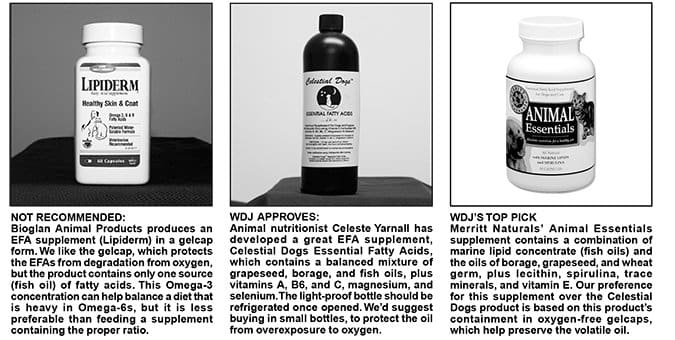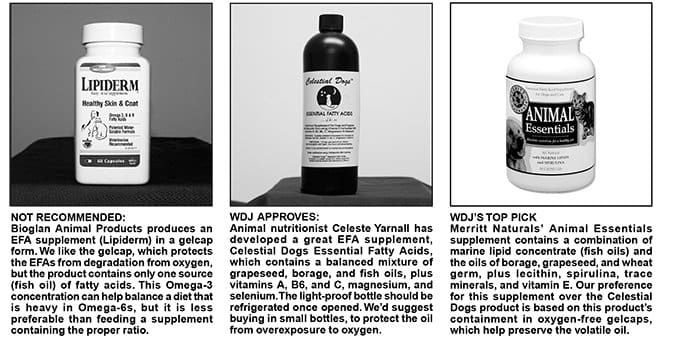[Updated December 3, 2018]
Most animal lovers know that dogs need high quality protein, fat, and a complete complement of vitamins and minerals in their diet to remain healthy. We know that the foods our canine companions eat should come from clean, wholesome sources, and that a good diet must be combined with ample exercise and a healthy living environment. But when planning a diet for a companion animal, many of us overlook some very important aspects of what constitutes complete nutrition for an animal. In fact, some important nutritional elements are omitted from the diets of millions of dogs, contributing to chronic disease and perhaps even premature death.
Selecting the proper type and quality of food for our dogs is just a start. We also must be assured that the foods we select actually contain the nutritional values that are needed, and that these values are delivered to the body in a form that can be readily absorbed and properly metabolized.
There are many factors that interfere with nutritional quality of pet foods. First, we must consider that many pet foods are comprised of ingredients that are of a much lower quality than humans demand, and lower quality foods are more difficult for an animal to digest and assimilate.

Second, we must consider that even the best brands of commercial pet foods (and many home-prepared diets) are prepared at high temperatures, meaning that many of the nutritional components they once contained are destroyed before they reach the food bowl. Third, we have to consider the effects of oxidation in commercially-prepared pet foods – especially kibble.
Many important nutritional components of dried kibble begin to degrade shortly after the food is manufactured, and often the food will sit in a warehouse for months before even reaching the retailer. Because of this, the discriminating animal guardian should never assume that everything on a pet food label still exists in the bag at the time of purchase.
Essential Fatty Acids Are Important to Dogs
At the top of the list of things commonly missing from the companion animal diet are essential fatty acids (EFAs). EFAs are fat-carried nutrients that every mammal needs to maintain healthy function and structure of smooth muscle organs (i.e. heart, reproductive system), to protect and build liver cells, and to maintain healthy skin, coat, and strong joint tissues. They have also been linked to retinal development and antioxidant activities, and they are responsible for the synthesis and modulation of various prostaglandins – chemicals that serve as mediators of various physiologic processes in the body. Most notably, prostaglandins act upon smooth muscle contractions of the heart and digestive tract, the initiation and regulation of inflammatory responses, and serve to inhibit excessive clotting of the blood.
In other words, if a body (animal or human) does not receive sufficient amounts of EFAs, critical body functions can be severely disrupted. Dogs and cats that are deficient of EFAs typically develop chronic skin and coat disorders, digestive problems, cardiovascular disease, degenerative eye disease, and allergies. Even animals who show no obvious signs of chronic disease will usually display dramatic benefits of an EFA-enriched diet very quickly. A shinier and softer coat, less shedding, healthier skin, fewer fleas, and better tolerance to flea bites and other allergens can be seen within just a few weeks of first feeding a top-quality EFA supplement. With all of this in mind, it’s easy to understand why EFAs should not be regarded as supplemental measures of nutrition, but as fundamental components of good health.
Omega-3 and Omega-6 for Dogs
Scientists categorize EFAs into two general groups. The first (alpha-linolenic acid) comprises the Omega-3 fatty acids, which are derived mostly from animal fats but also from flax seed oil (the richest source) and a few other vegetable oils. The second (linoleic acid) comprises Omega-6 fatty acids, which are available from many vegetable sources, most notably the seed oils of borage, evening primrose, and black current.
It’s just as important for the ratio of Omega-6 to Omega-3 EFAs to be correct as it is for dogs to have them in their diets. A ratio of about 4-1 Omega-6 to Omega-3 is considered optimum for dogs. Many commercial dog foods contain EFAs in ratios of 20-1; ratios of 50-1 or more (often seen in foods that contain lots of corn, which contains high levels of Omega-6 EFAs) will result in an Omega-3 deficiency.
All sources of EFAs are very unstable, meaning they tend to oxidize and break down very quickly, and are destroyed by heat, light, and oxygen. This is where our pet food problem begins.
The cooking of food (or canned food sterilizing) destroys the critical EFAs our animals need, and exposure to air breaks them down and renders them useless very quickly. Fish oils (an excellent source of Omega 3 fatty acids) are the fastest to go rancid. The oxidation and subsequent EFA degradation of flax seed, borage seed, evening primrose seed, or black current seed oil occurs more slowly, but nevertheless, these oils cannot be expected to remain viable for more than a few months – especially if the oil is exposed to oxygen (which, in a bottled or powdered supplement, can happen every evening at the dog’s meal time).
EFA supplements are often provided in the form of a bottled oil mixture that is added to the dog’s food daily in small amounts. But in the few weeks or months it can take to use a bottle of oil, the EFA content will progressively diminish. By the time half of a four- to eight-ounce bottle is gone, we will only be able to guess how much essential fatty acid is actually left.
While they sound like a great idea, EFA-fortified commercial foods are not a reliable source of EFAs. Not only are most prepared with heat (which can destroy naturally-occurring EFAs), they are also subject to oxidation. Even vacuum-packaged dry foods contain oxygen within each kibble, and there is no way of telling how much EFA remains in the food at the time of purchase, much less after the substance sits in an opened bag for several days.
The bottom line is this: the only way you can assure that your canine companion is getting sufficient amounts of EFAs is to add an EFA supplement to your dog’s diet yourself, using a guaranteed-fresh source packaged in an oxygen-free container.
I personally like the Animal Essentials Essential Fatty Acid Supplement that is produced by Merritt Naturals. This formula provides a diverse and balanced complement of EFAs as well as additional nutritional factors that promote healthy blood and skin structure. Best of all, they have contained the oils in convenient, easy-to-open soft gel capsules that prohibit air from contacting the formula until the feeding time. This optimizes shelf life of the product and helps assure that your companion actually receives the essential fatty acids he needs.
EFA Requirements and Dog Dosages
No exact requirements of these supplements have been established as yet. Exactly how of much of each type of essential fatty acid a particular animal needs remains questionable, but most experts agree that dogs need a balance of both Omega-3 and Omega-6 acids in their diets. Some EFAs are synthesized within an animal’s body, while others must be derived exclusively from dietary sources. EFA requirements may also vary according to animal type. For example, dogs can produce arachidonic acid (an important EFA component) whereas cats cannot. Instead, cats must receive arachidonic acid directly from their diets. Animal fats, evening primrose oil, and borage seed oil are all good sources of arachidonic acid.
Because the dietary needs and metabolic rates of EFA absorption vary between the type of oil and the systemic variations of each individual animal, it is best to feed EFAs from a variety of fish and vegetable seed oil sources. A commonly accepted dosage is about 400-600 mg. of the combined oils, fed daily for each 20 pounds of a dog’s body weight (e.g., a 60-pound dog would require 1200-1800 mg.).

Gregory Tilford is an herbalist and co-owner of Animals Apawthecary, of Conner, Montana, a source of herbal supplements for dogs and cats. He is also founding president of the Natural Pet Products Association and author of several books on wild medicinal plants.






Thanks for this great article!
OFA’s are, as you point out, truly essential and sadly under emphasized.
But one thing to note is that it is true… if left in a big container that is opened and closed every night or worse… if purchased in the “oh my God!” Size container at Costco… it is likely that the bottom of the barrel will be RANCID well before you give to your pet and maybe even take yourself…
What is not we’ll known is this:
It is better to NOT TAKE omegas at all than to take rancid omegas which can be detrimental to health and far worse outcomes occur over time than with deficiency!
Also you brought up- – don’t forget to check that the OMEGA 3 /OMEGA 6 ratios are correct before just calculating approx dose of the combined oils!
“A commonly accepted dosage is about 400-600 mg. of the combined oils, fed daily for each 20 pounds of a dog’s body weight “ IN THE PROPER RATIO !
Loved the article, but I can’t seem to find Merritt Naturals’ Animal Essentials supplements online. Can you include a link? Thank you!